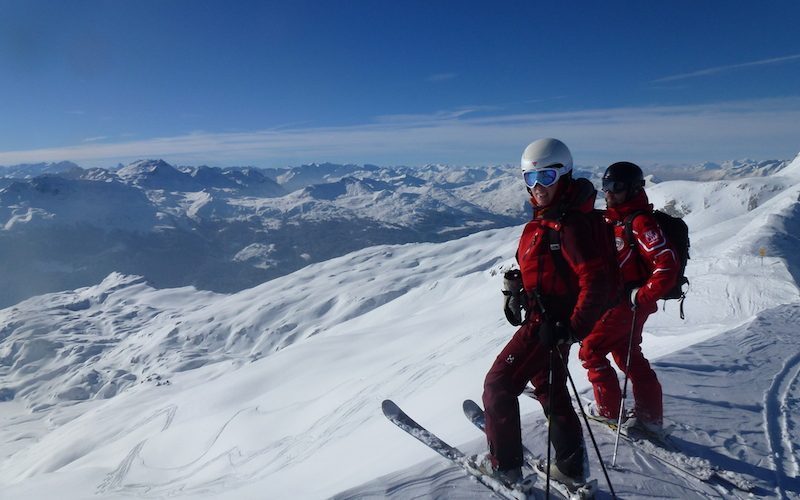It’s nearly −20°C, snowing hard, and I have no choice but to batten down the hatches and use a T-bar. With little ability to withstand cold, I’d normally be moaning, but this is worth it. I am in Klosters, which offers some of the best bad-weather skiing in the Swiss Alps, and some incredible – accessible – off-piste, too.
The lifts here are archaic. Klosters should actually be ashamed of itself for not re-investing more of the revenue from its fairly pricey lift passes on modernising its lift system. Most are T-bars, practically all of them are slow, and the weekend I visited in early-January, without exception, they were all very cold – make that, freezing.
Normally, this is not something to celebrate, and certainly not what I expected to find in a resort so well known for its connection with the royal family. But, having a shoddy old lift system helps keep down the numbers of skiers visiting this area, even better news because the off-piste is fantastic.
It’s early-January, and it’s snowing so hard the visibility is near zero. Our guide, Jorg, from the Klosters Ski School can barely keep us all together, but he has a big grin on his face. “There is 1000 vertical metres of tree skiing here,” he explains, leading us to the Gotschnagrat cable car, up to the Parsenn area for a dip into the snow beside the Schwartzseealp piste.
From the window of my hotel that morning the conditions looked amazing, so I was surprised to find the snow wind-blown, hard-packed and crusty. “It’s a test,” he said at the bottom, “the snow is always difficult here, I just wanted to make sure you are all up for what I have planned for the day.”
We passed muster, which meant enduring said horrible, cold T-bar, before heading on to ski Drostobel, a beautiful, north-facing run, formally an unpisted black. The markers were removed 10 years ago, so now it’s just an off-piste run and – ta da – we were the only ones on it, skiing in thigh-deep, beautifully light powder.
Next on to Chalbersaas, or “calves meadow” because livestock graze this area all summer, for yet another solitary run through the trees. It was magical and a complete surprise. If we had been in Bruson, Verbier, it would have been a bun fight for first tracks.
Handily, at the bottom of Chalbersaas is the Serneuser Schwendi restaurant and touring hut — a great place for a warming stew. Unpack yourself, and warm up on the sheepskin seats, and you won’t want to leave. Unless, of course, you’re hungry for more powder.
There’s a surprisingly big backcountry movement in Klosters, with tours and steeps everywhere you turn. Only no one shouts about it. The most famous, off the backside of Madrisa, is Kammerastaga “stairway to the moon”, or Rätschengang, with a 45° pitch from the summit of the 2703m Rätschenhorn.
From the highest point of the ski area, the Weissefluhgipfel, there’s another off-piste run known well to locals, the Diritissima. Or try the 7-hour day tour – 6000m vertical – dipping into Austria to the towns of St Antönier and Küblis. Or you can tour to Arosa, or St Moritz – the possibilities are endless.
I’m listing them, because I didn’t ski them, but Arc’teryx athlete, Klosters resident, and guide Peter Guyan described them to me in great detail. He counts Davos-Klosters as his favourite place to freeride in the world.
With the sun showing its face on day two, we headed away from the trees of Parsenn to the south-facing slopes of Madrisa, taking the lift and then hiking a short way up the Rätschenjoch (2600m) to access a beautiful, marked off-piste back to the base.
The scenery is spectacular, you feel on top of the world here when the sun is shining, and we did the same run time and again, each time taking a slightly different line, each time getting fresh tracks. The pitch wasn’t steep, but it didn’t need to be. The powder was feather-light and snow untouched. The pistes on Madrisa are mainly short, cruisey reds, and with the absence of black runs comes the more adventurous intermediates, eagerly spotting those easy free powder runs.
Being Switzerland, there is no shortage of fabulous lunch spots. We stopped in the Zuggenhutli for raclette — what else would you choose after an invigorating morning skiing powder? The Zuggenhutli has disabled access, and is host restaurant for Klosters’ Skiing With Heroes project.
Exhausted, and rather too full of cheese, we called it a day, but despite this lift system (that I might have mentioned one too many times), I’ll be back — though next time with touring kit.
Getting to Klosters
Abigail Butcher stayed at the 4★ Silvretta Park Hotel in Klosters (silvretta.ch), which costs CHF375 (£252) per night. A week’s package to Klosters, including flights, with Ski Safari (skisafari.com) at the Silvretta Park Hotel costs from £920pp, based on two sharing, with Easyjet flights to Zurich and second-class rail transfers.

